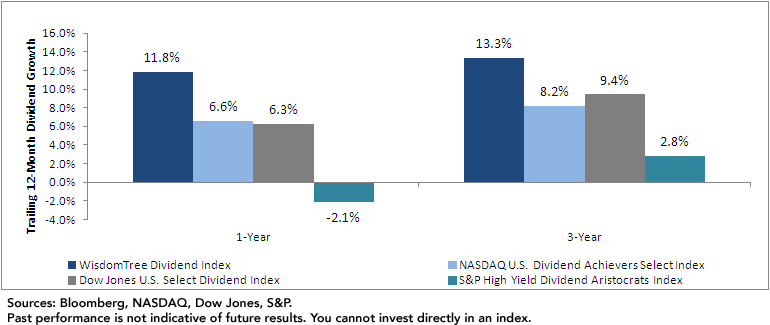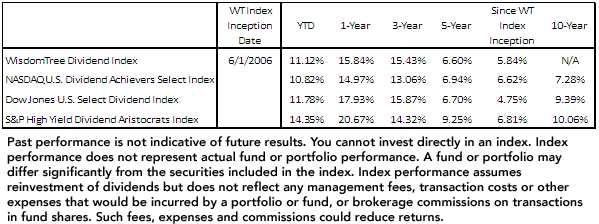The Drawback of Selecting Stocks Based on Backward Looking Dividend Growth



 Conclusion
The historical dividend growth requirements for the NASDAQ US Dividend Achievers Select, Dow Jones U.S. Select Dividend and S&P High Yield Dividend Aristocrats indexes affect the type of dividend growth that these indexes are able to capture. Over the last one- and three-year periods, all three indexes that screen based on historical dividend growth trends have seen their dividend growth considerably lag the dividend growth of a broad index of dividend payers with no restrictions on the types of dividend payers included.
The requirement for historical dividend increases keeps the very firms currently driving the fastest dividend growth out of many of these indexes. The WisdomTree Dividend Index, on the other hand, can include new or re-established dividend payers much more quickly, which explains its superior one- and three-year growth in trailing 12-month dividends.
View Jeremy Schwartz discuss dividends (Video)
Read our Dividend Growth series here.
Conclusion
The historical dividend growth requirements for the NASDAQ US Dividend Achievers Select, Dow Jones U.S. Select Dividend and S&P High Yield Dividend Aristocrats indexes affect the type of dividend growth that these indexes are able to capture. Over the last one- and three-year periods, all three indexes that screen based on historical dividend growth trends have seen their dividend growth considerably lag the dividend growth of a broad index of dividend payers with no restrictions on the types of dividend payers included.
The requirement for historical dividend increases keeps the very firms currently driving the fastest dividend growth out of many of these indexes. The WisdomTree Dividend Index, on the other hand, can include new or re-established dividend payers much more quickly, which explains its superior one- and three-year growth in trailing 12-month dividends.
View Jeremy Schwartz discuss dividends (Video)
Read our Dividend Growth series here.Important Risks Related to this Article
Dividends are not guaranteed and a company’s future abilities to pay dividends may be limited. A company currently paying dividends may cease paying dividends at any time.

Jeremy Schwartz has served as our Global Chief Investment Officer since November 2021 and leads WisdomTree’s investment strategy team in the construction of WisdomTree’s equity Indexes, quantitative active strategies and multi-asset Model Portfolios. Jeremy joined WisdomTree in May 2005 as a Senior Analyst, adding Deputy Director of Research to his responsibilities in February 2007. He served as Director of Research from October 2008 to October 2018 and as Global Head of Research from November 2018 to November 2021. Before joining WisdomTree, he was a head research assistant for Professor Jeremy Siegel and, in 2022, became his co-author on the sixth edition of the book Stocks for the Long Run. Jeremy is also co-author of the Financial Analysts Journal paper “What Happened to the Original Stocks in the S&P 500?” He received his B.S. in economics from The Wharton School of the University of Pennsylvania and hosts the Wharton Business Radio program Behind the Markets on SiriusXM 132. Jeremy is a member of the CFA Society of Philadelphia.

